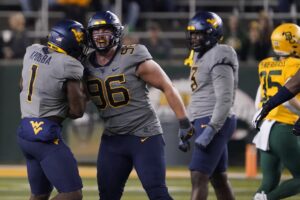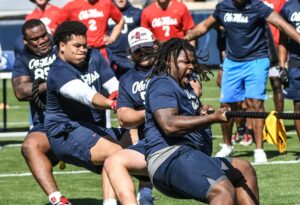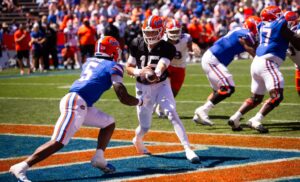Just over three months ago, Wisconsin fired its head coach after a 2-3 start to the season. The dismissal of Paul Chryst was a surprise to many given his track record in Madison. He was 67-26 since the 2015 season, leading the Badgers to three Big Ten title games and a Rose Bowl. The shaky start to the 2022 season didn’t appear to be reason enough to let him go, but other factors were at play.
Meanwhile, at Iowa, not much has changed since 1979 when Hayden Fry was hired to revive a bad Hawkeye football program. Just two head coaches and three athletic directors have walked the halls of the Hansen Football Performance Center since then. However, during that 44-year span, the need for change has never been dire. Only nine of those 44 seasons have finished with a record below .500. Removing those nine seasons, the Hawkeyes have averaged 8.3 wins per year. With the way college football programs fluctuate nowadays, that’s an incredibly stable history.
That historic consistency may be a redeeming quality and something to revere that few programs can claim. While true in many regards, the sport is progressing by the day. The way consistency will be built in the new age of college football is going to look different. Iowa has long excelled at program building by developing under-recruited players over three to four years. They’ll occasionally land highly-rated recruits, but more often than not their players fly under the radar. Now there’s a new variable in the equation. The transfer portal windows are transforming the art of program building. With the way things are trending, program success is going, to begin with, how well teams address player personnel needs on a window-to-window basis rather than how they are developed on a year-to-year basis.
Recognition and Major Change in Madison
In Madison, Chryst’s final two seasons saw a decline in recruiting numbers and growth. Following their close Rose Bowl loss in January 2020, Chryst took over play-calling duties from long-time assistant Joe Rudolph. Starter Jack Coan injured his foot in fall camp, and Graham Mertz was the highly-touted four-star recruit that came in and shined in his first start of the 2020 season. Coan transferred to Notre Dame at the end of 2020 and Mertz’s development plateaued. Chryst didn’t bring in a single quarterback from the transfer portal in 2021 or 2022 to challenge Mertz at the position. Since that Rose Bowl, Wisconsin’s record under Chryst was 15-10.
In their 2022 recruiting class, the Badgers uncharacteristically missed two top-rated offensive linemen. Four-stars and Wisconsin natives Carson Hinzman and Billy Schrauth both committed out of state. During the 2022 transfer portal window last January, there was a buzz about top quarterback Caleb Williams landing in Wisconsin. The move had merit as the Badgers had just hired a new offensive coordinator in Bobby Engram. His son Dean Engram, Williams’ former high school teammate, was also on the roster at receiver. However, Chryst reportedly never spoke directly with Williams in the transfer window. The quarterback went on to win the Heisman Trophy at USC this past season.
In addition to the poor start, these shortcomings at the recruiting level likely contributed to the decision to let Chryst go mid-way through the 2022 season. Wisconsin’s new athletic director Chris McIntosh was at the helm for just over one calendar year before making that decision. His timing was crucial as he recognized how the direction of their program was not aligned with the direction of college football. He pulled the plug.
Recognition but Minor Change in Iowa City
The 2022 season in Iowa City featured one of the worst statistical offensive productions in the recent history of college football. Iowa averaged 251 offensive yards per game. Since 2009, Only Wake Forest in 2014 and Washington State in 2009 averaged less than that at a Power Five level. Iowa went 49/176 on third downs this season, 27%, and gained an average of 4.2 yards per play.
There were clear deficiencies at all levels during the season, including within the coaching staff. However, Kirk Ferentz’s repeated mantra was to wait until the end of the season to evaluate and make the necessary changes. In fairness, that’s how he’s done it as the head coach at Iowa for 24 seasons. He has never made a mid-season coaching change, and the circumstances of 2022 weren’t going to change that.
The season ended, the transfer portal window opened and closed, and the early signing period came and went. Iowa’s football program made no coaching staff changes. It’s unlikely going forward that changes will be made now that several dozen new players have been introduced to the program with the current staff. It isn’t clear if Ferentz has done his evaluation of the coaching staff now that the season is over.
Transfer Portal Needs
On the other side of the equation, Iowa needed to take strides in the transfer portal. Entering the offseason, the Hawkeyes lost three four-star transfers in Jestin Jacobs, Arland Bruce IV, and Keagan Johnson. Nine other players including Terry Roberts and Alex Padilla left the program as well. Five of the 12 were on the defensive side, including Jacobs and Roberts. Both of whom were key contributors to Iowa’s top-rated defense. There was an exodus of several talented athletes and their spots needed filling.
To Iowa’s credit, they started off strong in the transfer portal window. It actually began before the window officially opened. Cade McNamara announced his commitment to Iowa on December first. The ball was rolling early, and other big names became targets including receivers Traeshon Holden and Isaac TeSlaa. On defense, names like Ernest Hausmann from Nebraska and Alex Washington from Harvard were on the Hawkeyes’ radar.
All four of those players committed elsewhere. At this point, Iowa has landed only five transfers including McNamara, and all play offense. Iowa has the 41st-ranked transfer class at the time of this writing. While each of these transfers will raise the floor of the offense next season, this transfer portal effort will not be sustainable year-to-year.
New Age Mentality
Wisconsin’s new athletic director recognized their shortfalls towards the end of the Chryst era. Rather than waiting until the end of the season to evaluate, McIntosh changed the direction of their program mid-season. It allowed them to get in front of the coaching search and start focusing on transforming their program. It resulted in landing Luke Fickell and 13 total transfers including four-star quarterback Tanner Mordecai from SMU, and four-star CJ Williams from USC at receiver. The Badgers currently have the ninth-ranked transfer portal class. The action taken at Wisconsin is going to change the look of their offense and the ceiling of their program in the immediate future.
This is not to say that Iowa should have done the same as Wisconsin and fired their head coach. Ferentz is a proven football coach and an excellent program builder over multiple decades. Rather, it’s the mentality that Iowa’s program needs to have to be successful in the new age of college football. If Wisconsin can do it, Ferentz is more than capable of doing similar things. The new mentality needs to focus on the “now”. Other coaches and athletic directors across the country have adopted this mentality in addition to Wisconsin.
Programs Around the Country
Arkansas head coach Sam Pittman was asked about his team’s mindset regarding players moving around in the portal. His response was, “Our mindset is if they want to go, then we’re going to go replace ‘em.” This is critical when several players leave in one transfer window. Iowa had 12 departures this year, and Arkansas had 26.
At Colorado, new head coach Deion Sanders brought in 23 transfer portal commitments within the first month of his tenure. In a team meeting, he said, “I ain’t got time to build… I ain’t got time to wait on you to get it right, we’re going to get guys who want it right now.” Another example of how the concept of player development will no longer be the leading factor in program building. The “now” is going to be critical for teams that want to compete for conference titles and national titles.
Will Iowa Keep Up in the Transfer Portal?
Over 1,600 players entered the portal in the first week of its opening on December 5th. The portal closed for entry on January 18th, and multiple thousand players had entered the portal in the transfer window. Talent acquisition in the transfer portal will become the centerpiece of successful college football teams, not program development. The way to compete with the best is to be aggressive in the portal as the best teams and coaches are currently doing. Florida State has landed seven four-star transfers thus far. LSU leads the transfer portal rankings with eight four-stars and 11 total commitments. Wisconsin’s ninth-ranked portal class is the highest in the Big Ten and they’ve added 13 commitments.
Athletes can continue to commit to schools even though the window has now closed. Iowa can still be productive in the transfer portal by landing some more players. As the offseason progresses, tracking Iowa’s transfer portal additions in relation to Wisconsin’s will give insight into the mindset of each program. Looking further out, comparing the results of the 2023 and 2024 seasons between the two programs will be enticing. One program fired its head coach and is currently in the process of a programmatic shift in philosophy to adapt to the changing landscape of the game. The other has a long track record of success in doing things their way. Iowa’s method is not necessarily wrong, it’s just built for a time that is trending towards becoming a strategy of the past. The new age of college football calls for a mentality adjustment, and Iowa can’t afford to get a step behind if they want to keep up within their own division.






